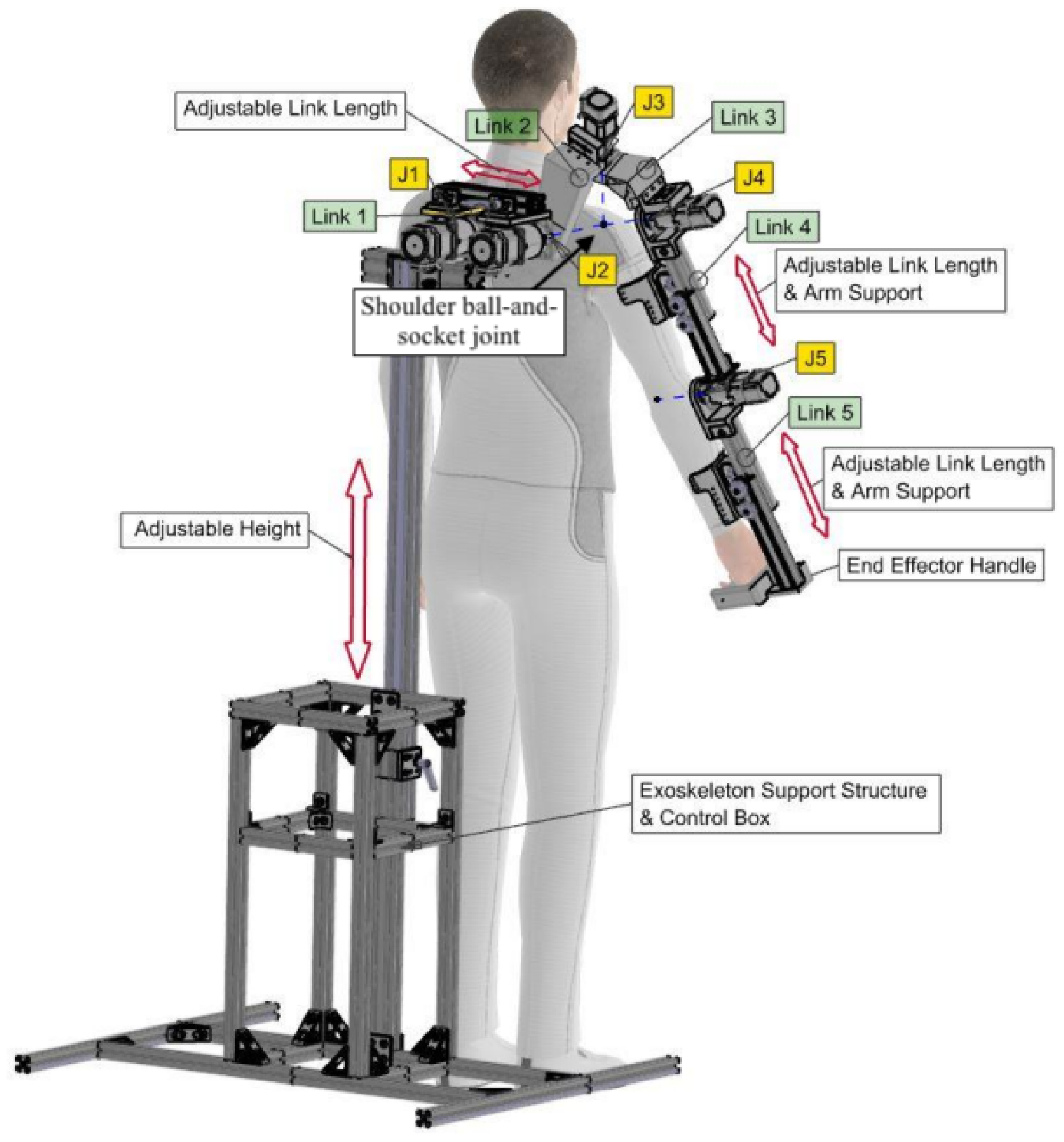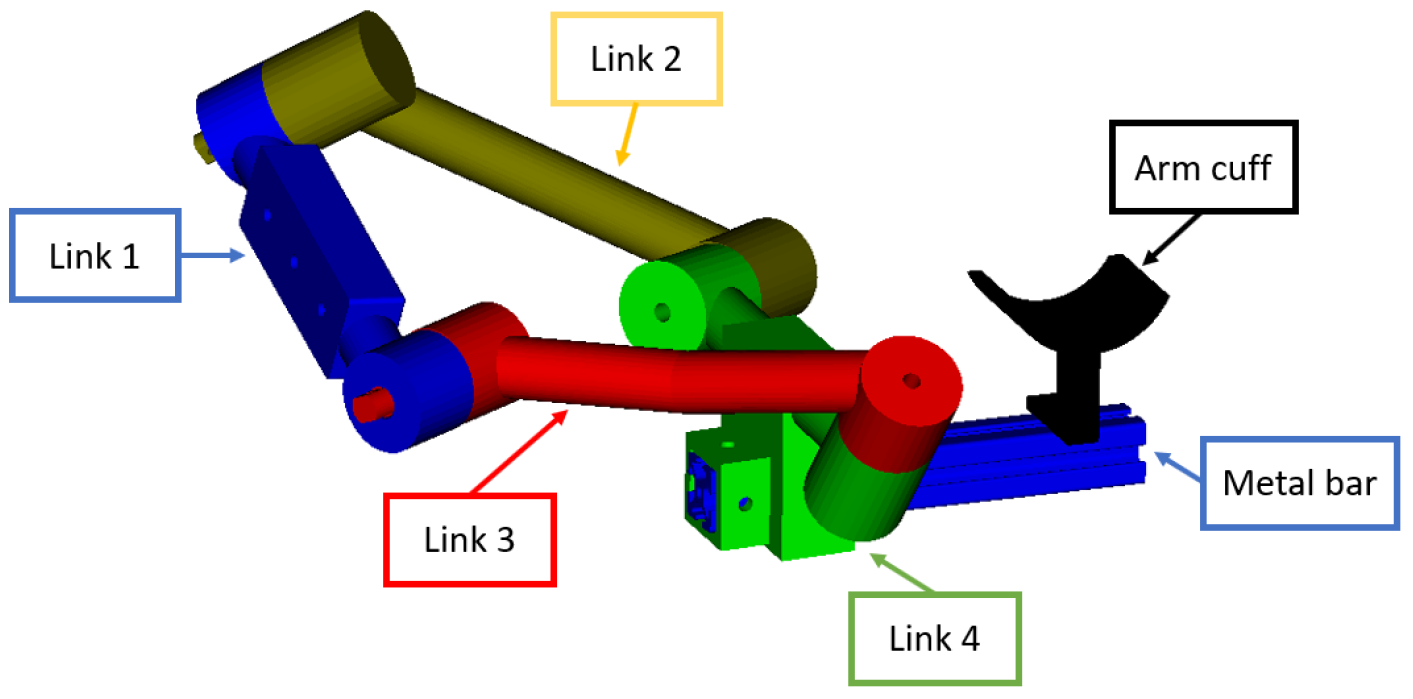Modeling of Human-Exoskeleton Alignment and Its Effect on the Elbow Flexor and Extensor Muscles during Rehabilitation
Abstract
1. Introduction
2. Exoskeleton Descriptions
2.1. Joint-Based Exoskeleton
2.2. Task-Based Exoskeleton
3. Methods
3.1. Modeling in OpenSim
3.1.1. Joint-Based Exoskeleton
3.1.2. Task-Based Exoskeleton
3.2. Simulating in OpenSim
3.2.1. Joint-Based Exoskeleton
3.2.2. Task-Based Exoskeleton
3.3. Quantifying Misalignment at the Elbow Joint
3.3.1. Joint-Based Exoskeleton
3.3.2. Task-Based Exoskeleton
4. Results
Muscle Tendon Length Variations from Misalignment
5. Discussion
6. Conclusions
Author Contributions
Funding
Data Availability Statement
Conflicts of Interest
Abbreviations
| IMU | Internal Measurement Unit |
| DOF | Degrees of Freedom |
| COR | Center of Rotation |
| IK | Inverse Kinematics |
| BK | Body Kinematics |
| MA | Muscle Analysis |
| UCL | Ulnar Collateral Ligament |
| BIClong | Biceps Long |
| BICshort | Biceps Short |
| BRA | Brachialis |
| BRD | Brachioradialis |
| TRIlong | Triceps Long |
| TRIlat | Triceps Lateral |
| TRImed | Triceps Medial |
| ANC | Anconeus |
References
- Meng, Q.; Xiang, S.; Yu, H. Soft robotic hand exoskeleton systems: Review and challenges surrounding the technology. In Proceedings of the 2017 2nd International Conference on Electrical, Automation and Mechanical Engineering (EAME 2017), Shanghai, China, 23–24 April 2017; Atlantis Press: Amsterdam, The Netherlands, 2017; pp. 186–190. [Google Scholar]
- Krichevets, A.N.; Sirotkina, E.; Yevsevicheva, I.; Zeldin, L. Computer games as a means of movement rehabilitation. Disabil. Rehabil. 1995, 17, 100–105. [Google Scholar] [CrossRef] [PubMed]
- Delgado, P.; Alekhya, S.; Majidirad, A.; Hakansson, N.A.; Desai, J.; Yihun, Y. Shoulder Kinematics Assessment towards Exoskeleton Development. Appl. Sci. 2020, 10, 6336. [Google Scholar] [CrossRef]
- Karavas, N.C.; Tsagarakis, N.G.; Caldwell, D.G. Design, modeling and control of a series elastic actuator for an assistive knee exoskeleton. In Proceedings of the 2012 4th IEEE RAS & EMBS International Conference on Biomedical Robotics and Biomechatronics (BioRob), Rome, Italy, 24–27 June 2012; IEEE: Piscataway Township, NJ, USA, 2012; pp. 1813–1819. [Google Scholar]
- MajidiRad, A.; Yihun, Y.; Desai, J.; Hakansson, N.A. Simulation of Exoskeleton Alignment and its Effect on the Knee Extensor and Flexor Muscles. In Proceedings of the 2019 41st Annual International Conference of the IEEE Engineering in Medicine and Biology Society (EMBC), Berlin, Germany, 23–27 July 2019; IEEE: Piscataway Township, NJ, USA, 2019; pp. 4093–4096. [Google Scholar]
- Zeiaee, A.; Soltani-Zarrin, R.; Langari, R.; Tafreshi, R. Design and kinematic analysis of a novel upper limb exoskeleton for rehabilitation of stroke patients. In Proceedings of the 2017 International Conference on Rehabilitation Robotics (ICORR), London, UK, 17–20 July 2017; IEEE: Piscataway Township, NJ, USA, 2017; pp. 759–764. [Google Scholar]
- Sposito, M.; Di Natali, C.; Toxiri, S.; Caldwell, D.G.; De Momi, E.; Ortiz, J. Exoskeleton kinematic design robustness: An assessment method to account for human variability. Wearable Technol. 2020, 1, e7. [Google Scholar] [CrossRef]
- De Kruif, B.J.; Schmidhauser, E.; Stadler, K.S.; O’Sullivan, L.W. Simulation architecture for modelling interaction between user and elbow-articulated exoskeleton. J. Bionic Eng. 2017, 14, 706–715. [Google Scholar] [CrossRef]
- Delgado, P.; Rincon, C.; Yihun, Y. Human-Exoskeleton Joint Coordination Assessment: A Case Study on the Shoulder and Elbow Joints. J. Bionic Eng. 2022, 16, 1712–1721. [Google Scholar] [CrossRef]
- Attampola Arachchige Don, T. Development of an Adaptive Exoskeleton for Upper Arm Rehabilitaion. Ph.D. Thesis, Wichita State University, Wichita, KS, USA, 2021. [Google Scholar]
- Delgado, P.; Arachchige Don, T.A.; Gomez, J.; Miranda, V.; Yihun, Y. Design of Bio-Exoskeleton for Elbow Rehabilitation. In Frontiers in Biomedical Devices; American Society of Mechanical Engineers: New York, NY, USA, 2021; Volume 84812, p. V001T10A002. [Google Scholar]
- Delp, S.L.; Anderson, F.C.; Arnold, A.S.; Loan, P.; Habib, A.; John, C.T.; Guendelman, E.; Thelen, D.G. OpenSim: Open-source software to create and analyze dynamic simulations of movement. IEEE Trans. Biomed. Eng. 2007, 54, 1940–1950. [Google Scholar] [CrossRef] [PubMed]
- Holzbaur, K.R.; Murray, W.M.; Delp, S.L. A model of the upper extremity for simulating musculoskeletal surgery and analyzing neuromuscular control. Ann. Biomed. Eng. 2005, 33, 829–840. [Google Scholar] [CrossRef] [PubMed]
- London, J.T. Kinematics of the elbow. J. Bone Jt. Surg. Am. Vol. 1981, 63, 529–535. [Google Scholar] [CrossRef]
- Solitro, G.F.; Fattori, R.; Smidt, K.; Nguyen, C.; Morandi, M.M.; Barton, R.S. Role of the transverse ligament of the ulnar collateral ligament of the elbow: A biomechanical study. JSES Int. 2021, 5, 549–553. [Google Scholar] [CrossRef] [PubMed]
- Frangiamore, S.J.; Bigart, K.; Nagle, T.; Colbrunn, R.; Millis, A.; Schickendantz, M.S. Biomechanical analysis of elbow medial ulnar collateral ligament tear location and its effect on rotational stability. J. Shoulder Elb. Surg. 2018, 27, 2068–2076. [Google Scholar] [CrossRef] [PubMed]
- Ruland, R.T.; Hogan, C.J.; Randall, C.J.; Richards, A.; Belkoff, S.M. Biomechanical comparison of ulnar collateral ligament reconstruction techniques. Am. J. Sports Med. 2008, 36, 1565–1570. [Google Scholar] [CrossRef] [PubMed]
- O’Driscoll, S.W.; Lawton, R.L.; Smith, A.M. The “moving valgus stress test” for medial collateral ligament tears of the elbow. Am. J. Sports Med. 2005, 33, 231–239. [Google Scholar] [CrossRef] [PubMed]
- Woo, S.L.Y.; Debski, R.E.; Zeminski, J.; Abramowitch, S.D.; Chan Saw, S.S.; Fenwick, J.A. Injury and repair of ligaments and tendons. Annu. Rev. Biomed. Eng. 2000, 2, 83–118. [Google Scholar] [CrossRef] [PubMed]











| x | y | z |
|---|---|---|
| −10.02 mm | −20.85 mm | −29.65 mm |
| Muscle | A | B | C | D | E | F | G | H |
|---|---|---|---|---|---|---|---|---|
| BIClong | 29.92 | 2.992 | 24.32 | 2.432 | 0.1126 | 0.463 | 0.0779 | 0.260 |
| BICshort | 25.27 | 2.527 | 19.84 | 1.984 | 0.1126 | 0.568 | 0.0779 | 0.305 |
| BRA | 3.68 | 0.368 | 0.72 | 0.072 | 0.0835 | 1.160 | 0.0495 | 6.875 |
| BRD | 21.22 | 2.122 | 10.95 | 1.095 | 0.1580 | 0.745 | 0.2893 | 1.363 |
| TRIlong | 22.86 | 2.286 | 25.86 | 2.586 | 0.0692 | 0.268 | 0.0214 | 0.083 |
| TRIlat | 8.64 | 0.864 | 11.57 | 1.157 | 0.0692 | 0.598 | 0.0214 | 0.185 |
| TRImed | 7.40 | 0.740 | 10.36 | 1.036 | 0.0692 | 0.668 | 0.0214 | 0.207 |
| ANC | 6.97 | 0.697 | 5.28 | 0.528 | 0.3581 | 6.782 | 0.2082 | 2.987 |
Disclaimer/Publisher’s Note: The statements, opinions and data contained in all publications are solely those of the individual author(s) and contributor(s) and not of MDPI and/or the editor(s). MDPI and/or the editor(s) disclaim responsibility for any injury to people or property resulting from any ideas, methods, instructions or products referred to in the content. |
© 2023 by the authors. Licensee MDPI, Basel, Switzerland. This article is an open access article distributed under the terms and conditions of the Creative Commons Attribution (CC BY) license (https://creativecommons.org/licenses/by/4.0/).
Share and Cite
Rincon, C.; Delgado, P.; Hakansson, N.A.; Yihun, Y. Modeling of Human-Exoskeleton Alignment and Its Effect on the Elbow Flexor and Extensor Muscles during Rehabilitation. Modelling 2023, 4, 351-365. https://doi.org/10.3390/modelling4030020
Rincon C, Delgado P, Hakansson NA, Yihun Y. Modeling of Human-Exoskeleton Alignment and Its Effect on the Elbow Flexor and Extensor Muscles during Rehabilitation. Modelling. 2023; 4(3):351-365. https://doi.org/10.3390/modelling4030020
Chicago/Turabian StyleRincon, Clarissa, Pablo Delgado, Nils A. Hakansson, and Yimesker Yihun. 2023. "Modeling of Human-Exoskeleton Alignment and Its Effect on the Elbow Flexor and Extensor Muscles during Rehabilitation" Modelling 4, no. 3: 351-365. https://doi.org/10.3390/modelling4030020
APA StyleRincon, C., Delgado, P., Hakansson, N. A., & Yihun, Y. (2023). Modeling of Human-Exoskeleton Alignment and Its Effect on the Elbow Flexor and Extensor Muscles during Rehabilitation. Modelling, 4(3), 351-365. https://doi.org/10.3390/modelling4030020






